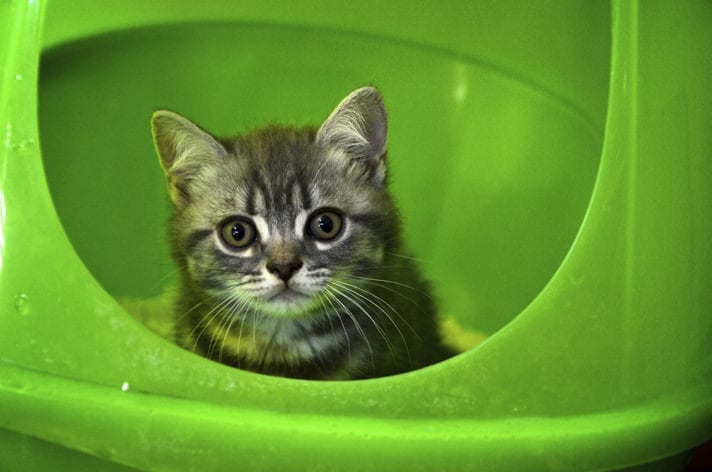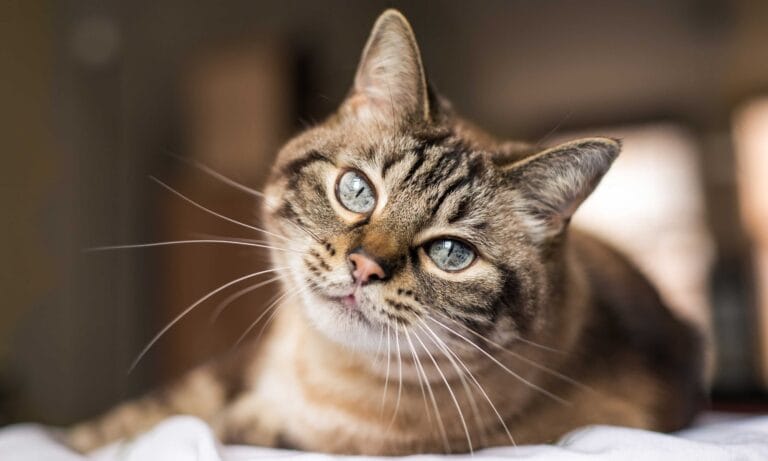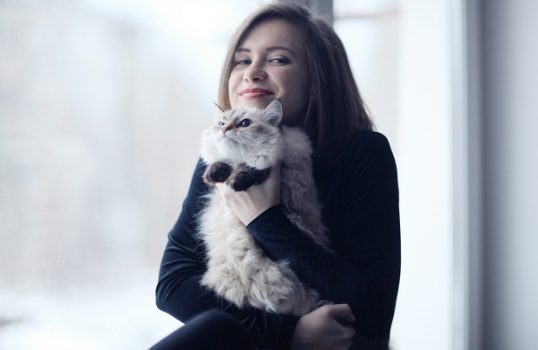The crazy days of being a cat probably occur during adolescence, from about 7 months old to 2 years old. Cute kittenhood is behind these cats, and the routine days of adulthood are yet to come. Although cats don’t frequently suffer from diarrhea, I’ve seen it strike cats of all ages during my more than 20 years as a veterinarian. And young, adolescent cats are not immune.
I’m currently chief of staff at the Animal House Of Chicago, and I’ll never forget this one young cat named Spike. Spike’s diarrhea was a result of his eating indoor houseplants that — although not toxic — resulted in chronic, intestinal irritation and diarrhea. We treated Spike for the diarrhea, and the owners decided that they loved him more than their plants. The plants found a new home and Spike no longer had bouts of diarrhea.
Diarrhea occurs for many reasons. Young cats develop diarrhea for many of the same reasons that kittens do, namely from dietary indiscretion, change of food or parasites. In my experience, the most common reason for a young cat to develop diarrhea is because he ate something inappropriate. Young cats can’t help being inquisitive, so that rubber band on the floor looks like it might be tasty. And that plant’s leaves look tasty, too. Ingesting any foreign material could cause gastrointestinal upset or worse.
Determining the cause of your young cat’s diarrhea gives you and your veterinarian the best chance to prevent it from happening again. Overactive thyroid, food allergies, renal failure, cancer, poisoning (from houseplants, rat poison, human medications, etc.), parasites, and infectious disease (among other things) can all result in diarrhea. Obtain veterinary assistance if the cause isn’t apparent or it is an ongoing problem. A food with fewer allergens or treatments for a disease might reduce or eliminate the diarrhea.
Recognizing Diarrhea In Cats
We all know the classic signs of diarrhea — frequent, urgent pooping of loose, watery stools —but a cat who has a bout of watery poop and then continues to strain is also suffering from diarrhea, not constipation.
The following signs of illness often accompany diarrhea:
- Fever
- Lethargy
- Malaise
- Loss of appetite
- Dehydration
Check your cat’s poop for signs of illness. If you find loose, watery stools and this persists more than a day, take a sample to your veterinarian.
Time For A Vet Visit?
Small-sized adult cats, along with kittens and senior cats, are at special risk of becoming dehydrated from even a single episode of diarrhea. Use this checklist to determine if you need to rush your cat to your veterinarian or can wait a day.
- If your cat seems OK after a single bout of diarrhea, it may be safe to simply monitor him. However, if you notice any lethargy, fever or change in behavior, call your veterinarian for the next available appointment.
- If your cat seems fine but has recurrent episodes of diarrhea that do not seem to be resolving, call your veterinarian for a non-emergency appointment.
- If your cat is passing blood in his poop or if you notice any weakness or other signs of debilitation along with the diarrhea, contact your veterinarian immediately and have your cat seen as soon as possible. Red blood in the poop usually indicates a problem with the lower intestine/colon or rectum. Black blood in the poop usually indicates a more serious problem higher up in the digestive tract.
- If your cat has no blood in his poop, consult with your veterinarian about over-the-counter medications or options for at-home treatments for your cat. Treatment varies because there are so many causes of diarrhea.
Pour On The Water
Water is critical for any cat suffering from diarrhea. The diarrhea not only causes a loss of fluid but also electrolytes, which are essential to help control important physiologic functions. Add some Pedialyte, an over-the-counter electrolyte beverage designed for infants and children, in your cat’s water to replace these. Water that includes 10 to 50 percent Pedialyte should do the trick. In my experience, cats accept the original, clear, unflavored Pedialyte the best.
You or your veterinarian can check your cat for dehydration using the pinch test. Gently pinch the normally loose skin at the back of your cat’s neck. If the skin snaps right back down, your cat is hydrated. If the pinched skin flattens slowly or remains tented, your cat is dehydrated. A dehydrated cat needs immediate veterinary care. If your veterinarian determines your young cat is dehydrated, supplemental fluids may be given either via intravenous or subcutaneous route. Drinking may no longer be adequate to get fluid into your cat.
What You Can Do For A Young Cat With Diarrhea
Changing Food
A young cat with diarrhea who otherwise seems healthy and is acting normally might benefit from a 12-hour food fast. Note this is food only, not water. Always provide plenty of water for a cat suffering from diarrhea.
When the 12-hour food fast ends, offer your cat a bland, fat-free food. Consider a fat-free prepared/canned cat food. Another option is cooked, ground turkey mixed with canned 100 percent pumpkin. If canned pumpkin is not easily found, try fresh, cooked sweet potato. Mix together equal parts turkey and pumpkin and feed it to your cat in small amounts, upping the frequency until the diarrhea resolves. If the diarrhea does not resolve in the first two to three days on a bland diet, consult your veterinarian if you haven’t already.
For some cases of diarrhea, it may be necessary to modify the diet permanently. You may need to give your cat special foods in order to avoid certain ingredients, add fiber to the diet and decrease the fat intake, or increase digestibility.
Natural Remedies
Slippery elm, peppermint, chamomile and homeopathic podophyllum might all offer some help in minimizing the side effects associated with intermittent diarrhea. Consult your veterinarian for all dosage recommendations. Metamucil can also be used to help resolve diarrhea. Adding half a teaspoon of Metamucil into your cat’s food with each meal, especially if he has soft poop, often normalizes the poop.
What Your Vet Can Do For A Young Cat With Diarrhea
If diarrhea continues for more than a day or if your young cat shows other signs of illness, including lethargy, vomiting, fever, dark-colored or bloody stools, straining to poop, decreased appetite or unexplained weight loss, it is time to visit the veterinarian.
Your veterinarian will examine your cat and run some tests. A sample of poop will be checked for the presence of internal parasites, overgrowth of bacteria or other fecal abnormalities. Blood work might identify other possible causes of the diarrhea.
The length of time your cat has been sick and the severity of your cat’s condition affect what other diagnostic tests might be recommended. These can include X-rays, ultrasound, cultures, endoscopy and biopsy.
To combat internal parasites, your vet may prescribe medication and/or a de-wormer. Not all de-wormers kill every kind of parasite, so the exact type of parasite(s) must be identified and the appropriate anti-parasitic medication(s) selected. De-worming might need to be repeated a few times, and you must clean areas your cat frequents to remove worm eggs.
Antibiotics will be prescribed if a bacterial infection is found or if the intestine appears to be damaged (blood in the poop is a sign of damage).
A drug that slows down the travel time of food in the GI tract can be prescribed, but only if the diarrhea was not caused by a toxin or bacterial infection. Such a drug would cause more problems in those instances. That’s why it’s so important to receive an accurate diagnosis for the cause of diarrhea.
Advice, Facts & More About Diarrhea In Cats
Keep these things in mind when treating diarrhea in your cat:
- Diarrhea is actually uncommon in cats.
- A cat who has frequent hairballs might also get diarrhea. In such a case, this might indicate a need to test for another underlying health issue, such as inflammatory bowel syndrome.
- Diarrhea from internal parasites or ingestion of inappropriate food could occur more often in cats who spend time outdoors.If your cat goes outside, check that your neighbors are not feeding him. Eating too much or eating food he is not used to can give a cat diarrhea. Poisonous plants are also a concern. The ASPCA Animal Poison Control Center has a list of toxic and non-toxic plants on its website.
- Just say no to giving milk, yogurt or other dairy foods to your cat. Your cat may like these foods and beg for them, but some cats can’t digest dairy foods, which can lead to gas or diarrhea.
- A sudden change in food could cause diarrhea. If you opt to change your cat’s food, do so by adding some of the new food to the old food, and gradually increase the amount of new food with every meal for a week or more. This allows your cat’s GI tract to adjust to the new food.
- Over-the-counter remedies like Pepto Bismol and Kaopectate are not for cats. These can cause salicylate toxicity in cats. Never give these to a cat.
- If someone in your home gets diarrhea at the same time that your cat has it, take the person to a doctor and your cat to the vet right away. There might be a microscopic parasite (Giardia or toxoplasmosis) that has infected both and is causing illness. Such parasites have the potential to become life-threatening to small children, elderly adults and those with compromised health.
- Please do not scold your cat for the accidents. He cannot help it, and adding stress may only make his diarrhea worse.
- Consult your veterinarian and be expected to answer questions about when the diarrhea began, how many bowel movements have occurred recently, what the poop looks like, whether your cat is uncomfortable and more.
- Call you veterinarian immediately if your cat has diarrhea and: blood in the diarrhea or the poop is black or tarry; you suspect your cat may have eaten something toxic or poisonous; a fever, is depressed or seems dehydrated, or if your cat’s gums are pale or yellow; has not received all his vaccinations; appears to be in pain or discomfort; is also vomiting
By: Dr. Byron de la Navarre
Featured Image: Via Kuonen Donat/iStock/Thinkstock
Share:









